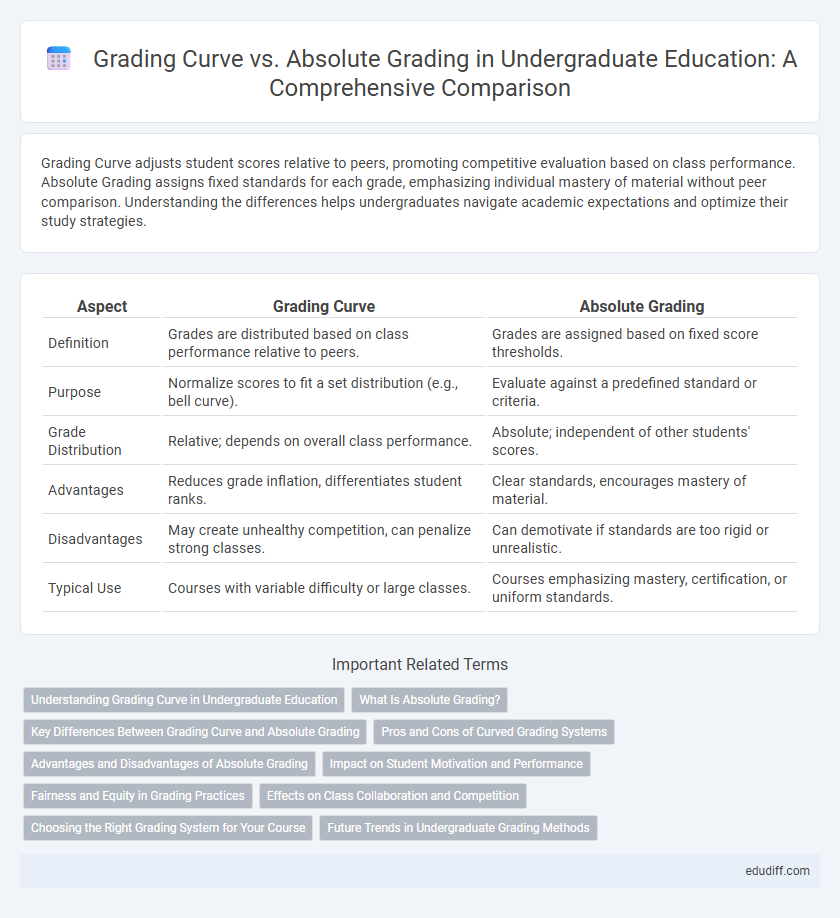Grading Curve adjusts student scores relative to peers, promoting competitive evaluation based on class performance. Absolute Grading assigns fixed standards for each grade, emphasizing individual mastery of material without peer comparison. Understanding the differences helps undergraduates navigate academic expectations and optimize their study strategies.
Table of Comparison
| Aspect | Grading Curve | Absolute Grading |
|---|---|---|
| Definition | Grades are distributed based on class performance relative to peers. | Grades are assigned based on fixed score thresholds. |
| Purpose | Normalize scores to fit a set distribution (e.g., bell curve). | Evaluate against a predefined standard or criteria. |
| Grade Distribution | Relative; depends on overall class performance. | Absolute; independent of other students' scores. |
| Advantages | Reduces grade inflation, differentiates student ranks. | Clear standards, encourages mastery of material. |
| Disadvantages | May create unhealthy competition, can penalize strong classes. | Can demotivate if standards are too rigid or unrealistic. |
| Typical Use | Courses with variable difficulty or large classes. | Courses emphasizing mastery, certification, or uniform standards. |
Understanding Grading Curve in Undergraduate Education
Understanding the grading curve in undergraduate education involves adjusting students' scores relative to their peers to normalize variations in exam difficulty and maintain consistent grade distributions. This system often uses statistical methods like standard deviation or percentile ranks to assign grades, promoting competitive evaluation within the cohort. Grading curves can impact class dynamics and student motivation by emphasizing relative performance rather than mastery of absolute standards.
What Is Absolute Grading?
Absolute grading assigns scores based on fixed criteria or standards where each grade corresponds to a specific range of percentages, regardless of how other students perform. This system allows clear benchmarks for achievement, such as 90-100% equating to an A, independent of class averages or distributions. Students are evaluated solely on their individual performance relative to established learning objectives, promoting transparency and consistency in assessment.
Key Differences Between Grading Curve and Absolute Grading
Grading curve adjusts student scores based on the overall performance distribution, often ranking students relative to each other, while absolute grading assigns grades according to fixed criteria or score thresholds. In curve grading, the highest-achieving student sets the benchmark, leading to potential grade competition, whereas absolute grading rewards all students who meet predetermined standards regardless of peer performance. The choice between these systems affects academic motivation, fairness perceptions, and grade inflation risks in undergraduate education.
Pros and Cons of Curved Grading Systems
Curved grading systems adjust student scores based on overall class performance, promoting competition and standardizing results across different exam difficulties. This method helps prevent grade inflation and encourages differentiation between high and low performers. However, curved grading can create stress, foster unhealthy competition, and may unfairly penalize students if the overall class performance is low.
Advantages and Disadvantages of Absolute Grading
Absolute grading provides clear benchmarks where students are assessed based on fixed criteria, promoting transparency and helping learners understand their exact performance relative to standards. One advantage is that it motivates students to meet predefined learning goals without competition-induced stress, fostering mastery of content. However, a significant disadvantage is that absolute grading may fail to account for variations in exam difficulty or cohort performance, potentially leading to grade inflation or deflation if standards don't align well with actual student abilities.
Impact on Student Motivation and Performance
Grading curve systems adjust student scores relative to peers, often intensifying competition and potentially undermining intrinsic motivation by fostering comparison rather than mastery. Absolute grading, based on fixed criteria, encourages students to focus on personal achievement and understanding, which can enhance sustained academic effort and self-improvement. Research indicates that absolute grading tends to promote higher overall student performance and motivation by providing clearer goals and rewarding individual progress.
Fairness and Equity in Grading Practices
Grading Curve adjusts student scores relative to peers, potentially creating competition and inconsistencies that impact fairness by emphasizing rank over mastery. Absolute Grading assigns fixed standards for performance, promoting equity by ensuring all students are assessed against the same criteria regardless of cohort variations. Fair grading practices balance these methods to support valid evaluations of student learning and maintain academic integrity.
Effects on Class Collaboration and Competition
Grading curves foster competition by ranking students against peers, which can undermine class collaboration and create a high-pressure environment. Absolute grading emphasizes mastery of material based on fixed criteria, encouraging cooperative learning and reducing anxiety about relative performance. Both systems impact student interactions differently, influencing the dynamics of teamwork and peer support in undergraduate courses.
Choosing the Right Grading System for Your Course
Choosing the right grading system for your course impacts student motivation and assessment accuracy. Grading curve adjusts scores relative to class performance, promoting competitive assessment but potentially skewing true mastery levels. Absolute grading evaluates performance against fixed standards, fostering clear learning objectives and consistency across cohorts.
Future Trends in Undergraduate Grading Methods
Emerging trends in undergraduate grading emphasize adaptive assessment models integrating AI-driven analytics to tailor grading curves dynamically. This shift aims to balance absolute grading's clarity with the curve's ability to account for cohort variability, enhancing fairness and motivation. Institutions increasingly explore hybrid systems leveraging continuous data to predict performance trajectories, signaling a move toward personalized educational assessment.
Grading Curve vs Absolute Grading Infographic

 edudiff.com
edudiff.com